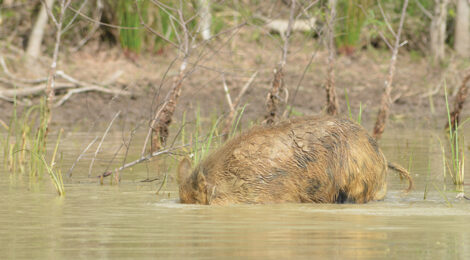
HOGS — WHERE’D THEY GO & WHAT TO DO
Story by Bill L. Olson
Wild hogs can irritate, frustrate and sometimes just puzzle those trying to control their ever-expanding numbers. Hunters will discover fresh swine sign. It may be pastures or crops torn up as they root for grubs, tubors or even soured grain placed in a covered hole as an attractant.
Observant hunters may spot a fresh wallow along a creek or stock tank where a hog has cooled its body temperature in the wet muck plus coated itself in mud to help get rid of skin-born parasites. Broken stands or panels in fences or even something as subtle as hog air on a barb of fencing along a game trail passing under a fence indicates the presence of invasive porkers.
The frustration escalates when hogs hit an area over several days or nights but then disappear leaving hunters wondering, “Where’d they go?” It seems hogs departure from an area may be based on a number of factors. Where they go can be equally challenging and calls for hunters to use several methods to pursue these dumb but smart animals.
The simple explanation is they may have depleted that area of whatever attracted them in the first place. It may be what they were foraging on, or it may be they no longer feel secure in an area. Did hunting pressure or some other form of hazing push them away from a place once visited?
We’ve seen hogs become educated when it comes to trapping. Box traps that catch a hog or two educate the rest of the untrapped sounder. Hogs become trap-shy and start avoiding baited enclosures. New techniques using larger traps that are baited for days to convince the sounder all is well as the tempting offering eventually overwhelms their sense of caution.
Many of these larger traps are rigged with a trip release to drop and capture most if not all of the sounder. This theory prevents any “educated pigs” from escaping the entrapment.
Wild hogs can irritate, frustrate and sometimes just puzzle those trying to control their ever-expanding numbers. Hunters will discover fresh swine sign. It may be pastures or crops torn up as they root for grubs, tubors or even soured grain placed in a covered hole as an attractant.
Observant hunters may spot a fresh wallow along a creek or stock tank where a hog has cooled its body temperature in the wet muck plus coated itself in mud to help get rid of skin-born parasites. Broken stands or panels in fences or even something as subtle as hog air on a barb of fencing along a game trail passing under a fence indicates the presence of invasive porkers.
The frustration escalates when hogs hit an area over several days or nights but then disappear leaving hunters wondering, “Where’d they go?” It seems hogs departure from an area may be based on a number of factors. Where they go can be equally challenging and calls for hunters to use several methods to pursue these dumb but smart animals.
The simple explanation is they may have depleted that area of whatever attracted them in the first place. It may be what they were foraging on, or it may be they no longer feel secure in an area. Did hunting pressure or some other form of hazing push them away from a place once visited?
We’ve seen hogs become educated when it comes to trapping. Box traps that catch a hog or two educate the rest of the untrapped sounder. Hogs become trap-shy and start avoiding baited enclosures. New techniques using larger traps that are baited for days to convince the sounder all is well as the tempting offering eventually overwhelms their sense of caution.
Many of these larger traps are rigged with a trip release to drop and capture most if not all of the sounder. This theory prevents any “educated pigs” from escaping the entrapment.








